Behavior driven development with calabash for android
- 1. Behavior Driven Development with Calabash for Android Teresa Holfeld | Ubilabs
- 2. Credits Teresa Holfeld Head of Mobile @ Ubilabs @TeresaHolfeld Selim Salman Android Evangelist Engineer @A_SelimS
- 4. Behavior Driven Development We want to do Scrum. We have a Product Owner who can’t code. This Product Owner has to write Acceptance Criteria for our tickets. We have to show them that the Acceptance Criteria are met. Can we agree on some format that makes it easier for both of us?
- 5. Behavior Driven Development Ruby: Cucumber Language: Gherkin
- 6. Behavior Driven Development Ruby: Cucumber Language: Gherkin Given <some precondition> When <some action by the actor> Then <some testable outcome is achieved>
- 7. Behavior Driven Development Ruby: Cucumber Language: Gherkin Mobile: Calabash ● Implements Cucumber ● Uses Gherkin Given <some precondition> When <some action by the actor> Then <some testable outcome is achieved>
- 8. Behavior Driven Development Ruby: Cucumber Language: Gherkin Mobile: Calabash ● Implements Cucumber ● Uses Gherkin Android: Calabash-android Given <some precondition> When <some action by the actor> Then <some testable outcome is achieved>
- 9. Gherkin
- 10. Gherkin ● Simple Domain Specific Language (DSL) with natural language constructs
- 11. Gherkin ● Simple Domain Specific Language (DSL) with natural language constructs Given <some precondition> When <some action by the actor> Then <some testable outcome is achieved>
- 12. Gherkin ● Simple Domain Specific Language (DSL) with natural language constructs Scenario: Multiple Givens Given one thing Given another thing Given yet another thing When I open my eyes Then I see something Then I don't see something else
- 13. Gherkin ● Simple Domain Specific Language (DSL) with natural language constructs Scenario: Multiple Givens Given one thing And another thing And yet another thing When I open my eyes Then I see something But I don't see something else
- 14. Cucumber
- 15. Cucumber Cucumber: ● Software tool for writing automated acceptance tests in BDD ● Gherkin: Given - When - Then ● Origin: Ruby
- 16. Cucumber Cucumber: ● Software tool for writing automated acceptance tests in BDD ● Gherkin: Given - When - Then ● Origin: Ruby ● Java, JavaScript, C#, PHP
- 17. Cucumber Keywords: ● Feature ● Scenario ● Given, When, Then, And, But ● Background ● Scenario Outline ● Examples
- 18. Cucumber Feature, Scenario Feature: Load tracks of the releases of a record label. Scenario: As a user I want to load all tracks for all records of a given record label. Given I see the record label “Rivulet Records” And I see the record “Closed Sessions” And I see the artist “Various” When I press “Show all tracks” And I wait for 3 seconds Then I see “Sigil Magic, How To Lose Orientation, This Is The Game We Play, So Fi Trance, Closed Session”
- 19. Cucumber Background Feature: Load tracks of the releases of a record label. Background: Given I see a search field When I type “Rivulet Records” into the search field And I wait for 3 seconds Then I see “Rivulet Records” # this is the record label And I see “Closed Sessions” # this is the album Scenario: As a user I want to load all tracks for all records of a given record label. Given I see the record label “Rivulet Records” And I see the record “Closed Sessions” And I see the artist “Various” When I press “Show all tracks” [...]
- 20. Cucumber Scenario Outline, Examples Scenario: As a user I want to load all tracks for the record “Closed Sessions” of the label “Rivulet Records”. Given I see the record label “Rivulet Records” And I see the record “Closed Sessions” When I press “Show all tracks” Then I see “Sigil Magic, How To Lose Orientation, This Is The Game We Play, So Fi Trance, Closed Session” Scenario: As a user I want to load all tracks for the record “Floating Woven” of the label “Paradise Now”. Given I see the record label “Paradise Now” And I see the record “Floating Woven” When I press “Show all tracks” Then I see “Gerold Dub, Meridia 02509, Floating Woven”
- 21. Cucumber Scenario Outline, Examples Scenario: As a user I want to load all tracks for the record “Closed Sessions” of the label “Rivulet Records”. Given I see the record label “Rivulet Records” And I see the record “Closed Sessions” When I press “Show all tracks” Then I see “Sigil Magic, How To Lose Orientation, This Is The Game We Play, So Fi Trance, Closed Session” Scenario: As a user I want to load all tracks for the record “Floating Woven” of the label “Paradise Now”. Given I see the record label “Paradise Now” And I see the record “Floating Woven” When I press “Show all tracks” Then I see “Gerold Dub, Meridia 02509, Floating Woven”
- 22. Cucumber Scenario Outline, Examples Scenario Outline: As a user I want to load all tracks for a given record of a given label. Given I see the record label <label> And I see the record <record> When I press “Show all tracks” Then I see <tracks> Examples: | label | record | tracks | | Rivulet Records | Closed Sessions | Sigil Magic, [...] | | Paradise Now | Floating Woven | Gerold Dub, [...] | https://cucumber.io/docs/reference
- 23. Cucumber Step Definitions Scenario: As a user I want to load all tracks for all records of a given record label. Given I see the record label “Rivulet Records” Given(/I see the record label “([^”]*)”$/) do |label| puts “Record label: #{label}” end
- 24. Calabash
- 25. Calabash
- 26. Calabash
- 27. Calabash
- 28. Calabash Calabash: ● Framework for automated acceptance tests for iOS and Android ● By Xamarin Calabash-android: ● Calabash testing framework for Android ● Uses Cucumber + Gherkin ● Ruby
- 29. Calabash How does it work? Android app wrapper around Robotium Exposes view hierarchy as HTML server Calabash Ruby framework talks to this HTML server
- 31. Calabash
- 38. Calabash Canned steps: steps the framework already implemented for you Step Definitions: how to define your own steps Ruby API: what you can use for implementing your own steps
- 39. Calabash - Canned Steps Check if text is there: Then /^I see "([^"]*)"$/ Then /^I should see "([^"]*)"$/
- 40. Calabash - Canned Steps Check if text is there: Then /^I see "([^"]*)"$/ Then /^I should see "([^"]*)"$/ Check if text is not there: Then /^I should not see "([^"]*)"$/ Then /^I don't see "([^"]*)"$/
- 41. Calabash - Canned Steps Input actions: Then /^I toggle checkbox number (d+)$/ do |index| Then /^I enter "([^"]*)" into input field number (d+)$/ do |text, index|
- 42. Calabash - Canned Steps Input actions: Then /^I toggle checkbox number (d+)$/ do |index| Then /^I enter "([^"]*)" into input field number (d+)$/ do |text, index| Touching: Then /^I press the "([^"]*)" button$/ do |text| Then /^I click on screen (d+)% from the left and (d+)% from the top$/ do |x, y|
- 43. Calabash - Canned Steps Input actions: Then /^I toggle checkbox number (d+)$/ do |index| Then /^I enter "([^"]*)" into input field number (d+)$/ do |text, index| Touching: Then /^I press the "([^"]*)" button$/ do |text| Then /^I click on screen (d+)% from the left and (d+)% from the top$/ do |x, y| Buttons: Then /^I go back$/ Then /^I press the menu key$/
- 44. Calabash - Canned Steps Gestures: Then /^I swipe left$/ Then /^I scroll down$/
- 45. Calabash - Canned Steps Gestures: Then /^I swipe left$/ Then /^I scroll down$/ Waiting: Then /^I wait for (d+) seconds$/ do |seconds| Then /^I wait up to (d+) seconds for "([^"]*)" to appear$/ do |timeout, text|
- 46. Calabash - Canned Steps Even more: https://github.com/calabash/calabash-android/blob/master/ruby-gem/lib/calabash- android/canned_steps.md
- 47. Calabash - Step Definitions Then(/^I see a map$/) do map_view = element_exists("MapView") if not map_view screenshot_and_raise "No map view found!" end end
- 48. Calabash - Step Definitions Setting a geolocation: Then(/^I set my location to (d+).(d+), (d+).(d+)$/) do |arg1, arg2, arg3, arg4| lat = "#{arg1}.#{arg2}" long = "#{arg3}.#{arg4}" set_gps_coordinates(lat, long) end
- 49. Calabash - Advanced Stuff Referencing steps: Given(/^I checked if notes are empty$/) do steps %Q{ Given I see the "Notes" button When I press the "Notes" button Then I see "No notes." } end
- 50. Calabash - Advanced Stuff Repeating steps: Given(/^I entered (d+) note(?:s)?$/) do |n| for i in 1..n.to_i steps %Q{ Given I see "New Note" When I press "New Note" And I enter "Note #{i}" into the note field And I press "Save" Then I see "Note #{i}" } end end
- 51. Calabash - Ruby API > query("FrameLayout index:0") [ [0] { "id" => "content", "enabled" => true, "contentDescription" => nil, "class" => "android.widget.FrameLayout", "rect" => { "center_y" => 617.0, "center_x" => 384.0, "height" => 1134, "y" => 50, "width" => 768, "x" => 0 }, "description" => "android.widget.FrameLayout{41f40dc0 V.E..... ........ 0,50-768,1184 #1020002 android:id/content}" } ]
- 52. Calabash - Ruby API element_exists(uiquery) element_does_not_exist(uiquery)
- 53. Calabash - Ruby API element_exists(uiquery) element_does_not_exist(uiquery) wait_for_elements_exist(elements_arr, options={}) wait_for_elements_exist( ["button marked:'OK'", "* marked:'Cancel'"], :timeout => 2)
- 54. Calabash - Ruby API fail(msg) fail(msg="Error. Check log for details.")
- 55. Calabash - Ruby API fail(msg) fail(msg="Error. Check log for details.") screenshot(options={:prefix=>nil, :name=>nil}) screenshot({:prefix => "/tmp", :name => "my.png"})
- 56. Calabash - Ruby API fail(msg) fail(msg="Error. Check log for details.") screenshot(options={:prefix=>nil, :name=>nil}) screenshot({:prefix => "/tmp", :name => "my.png"}) screenshot_and_raise(msg, options) screenshot_and_raise(msg="Error. Check log for details.", options={:prefix => "/tmp", :name => "error.png"})
- 57. Calabash - Ruby API And much more: https://github.com/calabash/calabash-android/blob/master/documentation/ruby_ap i.md
- 58. Calabash - Documentation and Tutorials Calabash Android GitHub: https://github.com/calabash/calabash-android Calabash Ruby API: https://github.com/calabash/calabash-android/blob/master/documentation/ruby_ap i.md Calabash Developer Site: https://developer.xamarin.com/guides/testcloud/calabash/ Testmunk Documentation and Tutorials: https://testmunk.readthedocs.io/en/latest/
- 60. Alternatives ● Cucumber-android + Espresso ● Espresso and comments ● JBehave ● Concordion ● JDave ● Easyb
- 61. Yay or nay? + Serves as a technical documentation + Non-tech staff can understand + Enforces well-defined acceptance criteria + Easy to run, easy to learn - Comes with overhead: have to develop steps in Ruby - You have to implement certain things yourself (e.g. scrolling in RecyclerView) - You need to convince your Product Owner to write acceptance criteria m(
- 62. Teresa Holfeld Head of Mobile @ Ubilabs @TeresaHolfeld
- 64. www.ubilabs.net/jobs And also thank you for listening. Questions welcome!
- 65. Calabash - Advanced Stuff Resuming an Activity: Then(/^I resume the app$/) do system("#{default_device.adb_command} shell am start -n com.example.calabash.MainActivity") end
- 66. Calabash - Canned Steps Gestures: Then /^I swipe left$/ Then /^I swipe right$/ Then /^I scroll down$/ Then /^I scroll up$/ Then /^I select "([^"]*)" from the menu$/ do |identifier| Then /^I drag from (d+):(d+) to (d+):(d+) moving with (d+) steps$/ do |from_x, from_y, to_x, to_y, steps| x:y co-ordinates are expressed as percentages of the screen width:height.
- 67. Calabash - Canned Steps Waiting: Then /^I wait for 1 second$/ # 1 second Then /^I wait for a second$/ # 1 second Then /^I wait$/ # 2 seconds Then /^I wait for (d+) seconds$/ do |seconds| # specified number of seconds
- 68. Calabash - Canned Steps Waiting: Then /^I wait for 1 second$/ # 1 second Then /^I wait for a second$/ # 1 second Then /^I wait$/ # 2 seconds Then /^I wait for (d+) seconds$/ do |seconds| # specified number of seconds Then /^I wait for "([^"]*)" to appear$/ do |text| Then /^I wait up to (d+) seconds for "([^"]*)" to appear$/ do |timeout, text| Then /^I wait up to (d+) seconds to see "([^"]*)"$/ do |timeout, †ext|











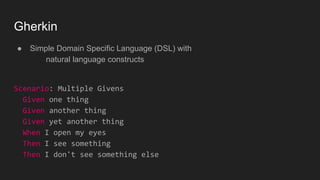




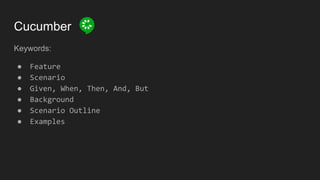
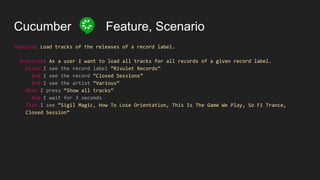
![Cucumber Background
Feature: Load tracks of the releases of a record label.
Background:
Given I see a search field
When I type “Rivulet Records” into the search field
And I wait for 3 seconds
Then I see “Rivulet Records” # this is the record label
And I see “Closed Sessions” # this is the album
Scenario: As a user I want to load all tracks for all records of a given record label.
Given I see the record label “Rivulet Records”
And I see the record “Closed Sessions”
And I see the artist “Various”
When I press “Show all tracks”
[...]](https://image.slidesharecdn.com/behaviordrivendevelopmentwithcalabashforandroid-161205085525/85/Behavior-driven-development-with-calabash-for-android-19-320.jpg)
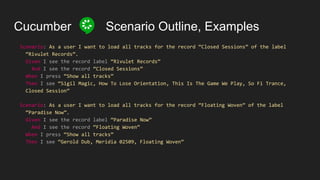
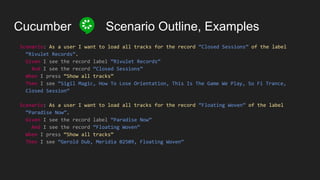
![Cucumber Scenario Outline, Examples
Scenario Outline: As a user I want to load all tracks for a given record of a given label.
Given I see the record label <label>
And I see the record <record>
When I press “Show all tracks”
Then I see <tracks>
Examples:
| label | record | tracks |
| Rivulet Records | Closed Sessions | Sigil Magic, [...] |
| Paradise Now | Floating Woven | Gerold Dub, [...] |
https://cucumber.io/docs/reference](https://image.slidesharecdn.com/behaviordrivendevelopmentwithcalabashforandroid-161205085525/85/Behavior-driven-development-with-calabash-for-android-22-320.jpg)
![Cucumber Step Definitions
Scenario: As a user I want to load all tracks for all records of a given record label.
Given I see the record label “Rivulet Records”
Given(/I see the record label “([^”]*)”$/) do |label|
puts “Record label: #{label}”
end](https://image.slidesharecdn.com/behaviordrivendevelopmentwithcalabashforandroid-161205085525/85/Behavior-driven-development-with-calabash-for-android-23-320.jpg)




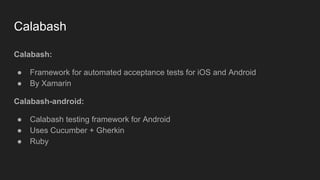





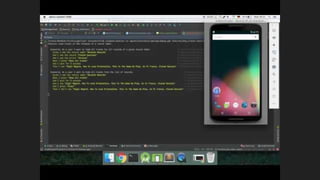



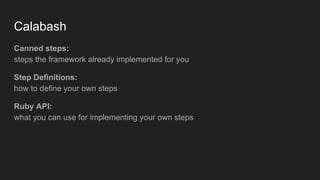
![Calabash - Canned Steps
Check if text is there:
Then /^I see "([^"]*)"$/
Then /^I should see "([^"]*)"$/](https://image.slidesharecdn.com/behaviordrivendevelopmentwithcalabashforandroid-161205085525/85/Behavior-driven-development-with-calabash-for-android-39-320.jpg)
![Calabash - Canned Steps
Check if text is there:
Then /^I see "([^"]*)"$/
Then /^I should see "([^"]*)"$/
Check if text is not there:
Then /^I should not see "([^"]*)"$/
Then /^I don't see "([^"]*)"$/](https://image.slidesharecdn.com/behaviordrivendevelopmentwithcalabashforandroid-161205085525/85/Behavior-driven-development-with-calabash-for-android-40-320.jpg)
![Calabash - Canned Steps
Input actions:
Then /^I toggle checkbox number (d+)$/ do |index|
Then /^I enter "([^"]*)" into input field number (d+)$/ do |text, index|](https://image.slidesharecdn.com/behaviordrivendevelopmentwithcalabashforandroid-161205085525/85/Behavior-driven-development-with-calabash-for-android-41-320.jpg)
![Calabash - Canned Steps
Input actions:
Then /^I toggle checkbox number (d+)$/ do |index|
Then /^I enter "([^"]*)" into input field number (d+)$/ do |text, index|
Touching:
Then /^I press the "([^"]*)" button$/ do |text|
Then /^I click on screen (d+)% from the left and (d+)% from the top$/ do |x, y|](https://image.slidesharecdn.com/behaviordrivendevelopmentwithcalabashforandroid-161205085525/85/Behavior-driven-development-with-calabash-for-android-42-320.jpg)
![Calabash - Canned Steps
Input actions:
Then /^I toggle checkbox number (d+)$/ do |index|
Then /^I enter "([^"]*)" into input field number (d+)$/ do |text, index|
Touching:
Then /^I press the "([^"]*)" button$/ do |text|
Then /^I click on screen (d+)% from the left and (d+)% from the top$/ do |x, y|
Buttons:
Then /^I go back$/
Then /^I press the menu key$/](https://image.slidesharecdn.com/behaviordrivendevelopmentwithcalabashforandroid-161205085525/85/Behavior-driven-development-with-calabash-for-android-43-320.jpg)

![Calabash - Canned Steps
Gestures:
Then /^I swipe left$/
Then /^I scroll down$/
Waiting:
Then /^I wait for (d+) seconds$/ do |seconds|
Then /^I wait up to (d+) seconds for "([^"]*)" to appear$/ do |timeout, text|](https://image.slidesharecdn.com/behaviordrivendevelopmentwithcalabashforandroid-161205085525/85/Behavior-driven-development-with-calabash-for-android-45-320.jpg)

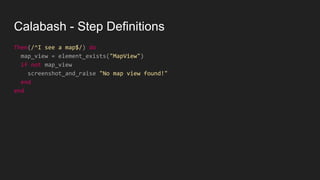
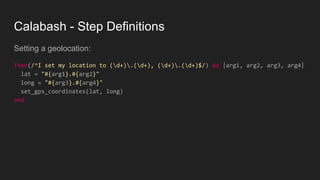


![Calabash - Ruby API
> query("FrameLayout index:0")
[
[0] {
"id" => "content",
"enabled" => true,
"contentDescription" => nil,
"class" => "android.widget.FrameLayout",
"rect" => {
"center_y" => 617.0,
"center_x" => 384.0,
"height" => 1134,
"y" => 50,
"width" => 768,
"x" => 0
},
"description" => "android.widget.FrameLayout{41f40dc0 V.E..... ........ 0,50-768,1184 #1020002
android:id/content}"
}
]](https://image.slidesharecdn.com/behaviordrivendevelopmentwithcalabashforandroid-161205085525/85/Behavior-driven-development-with-calabash-for-android-51-320.jpg)

![Calabash - Ruby API
element_exists(uiquery)
element_does_not_exist(uiquery)
wait_for_elements_exist(elements_arr, options={})
wait_for_elements_exist( ["button marked:'OK'", "* marked:'Cancel'"], :timeout => 2)](https://image.slidesharecdn.com/behaviordrivendevelopmentwithcalabashforandroid-161205085525/85/Behavior-driven-development-with-calabash-for-android-53-320.jpg)





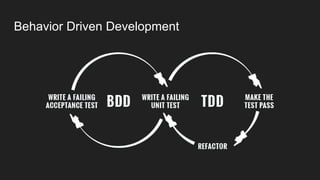




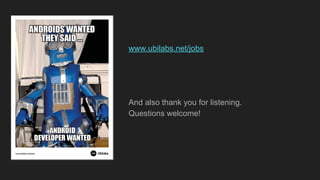

![Calabash - Canned Steps
Gestures:
Then /^I swipe left$/
Then /^I swipe right$/
Then /^I scroll down$/
Then /^I scroll up$/
Then /^I select "([^"]*)" from the menu$/ do |identifier|
Then /^I drag from (d+):(d+) to (d+):(d+) moving with (d+) steps$/ do
|from_x, from_y, to_x, to_y, steps|
x:y co-ordinates are expressed as percentages of the screen width:height.](https://image.slidesharecdn.com/behaviordrivendevelopmentwithcalabashforandroid-161205085525/85/Behavior-driven-development-with-calabash-for-android-66-320.jpg)
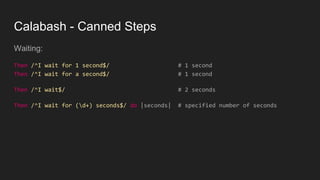
![Calabash - Canned Steps
Waiting:
Then /^I wait for 1 second$/ # 1 second
Then /^I wait for a second$/ # 1 second
Then /^I wait$/ # 2 seconds
Then /^I wait for (d+) seconds$/ do |seconds| # specified number of seconds
Then /^I wait for "([^"]*)" to appear$/ do |text|
Then /^I wait up to (d+) seconds for "([^"]*)" to appear$/ do |timeout, text|
Then /^I wait up to (d+) seconds to see "([^"]*)"$/ do |timeout, †ext|](https://image.slidesharecdn.com/behaviordrivendevelopmentwithcalabashforandroid-161205085525/85/Behavior-driven-development-with-calabash-for-android-68-320.jpg)